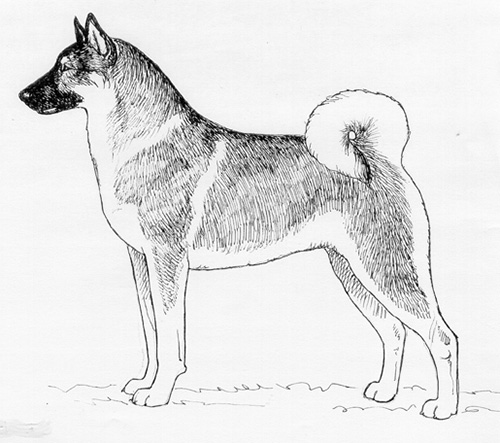Swedish Elkhound
Northern Breed Group
The goals and purposes of this breed standard include: to furnish guidelines for breeders who wish to maintain the quality of their breed and to improve it; to advance this breed to a state of similarity throughout the world; and to act as a guide for judges.
Breeders and judges have the responsibility to avoid any conditions or exaggerations that are detrimental to the health, welfare, essence and soundness of this breed, and must take the responsibility to see that these are not perpetuated.
Any departure from the following should be considered a fault, and the seriousness with which the fault should be regarded should be in exact proportion to its degree and its effect upon the health and welfare of the dog and on the dog’s ability to perform its traditional work.
History
The Swedish Elkhound is a breed with ancient origins, though it was only recognized as a separate breed in 1946, because it used to be shown together with the smaller Norwegian Elkhound. The breed was mainly used for hunting Elk, though it was sometimes used on bear and lynx as well.
The Swedish Elkhound was recognized by the United Kennel Club in 2006.
General Appearance
The Swedish Elkhound is a large, rectangular spitz breed, clean cut, strong, substantial and agile. It must not give the impression of having a long body or of being overly heavy in body, as it is a breed known for great endurance.
Fault: Fine bone.
Characteristics
Courageous and energetic, but also stoically calm.
Head
The head is clean cut, and rather long.
SKULL
Broad between the ears, slightly arched. The stop is well defined but not too deep.
Serious Faults: Domed forehead, and bulging cheeks.
MUZZLE
The muzzle is slightly shorter in length than the skull. It tapers in width from the stop to the nose. It must not be snipy. The nasal bridge is straight, strong and broad. The lips are tight fitting and the cheeks are clean.
Serious Fault: Snipy muzzle.
TEETH
The Swedish Elkhound has a complete set of evenly spaced, white teeth meeting in a scissors bite.
Serious Fault: Missing teeth other than P1.
Disqualification: Overshot or undershot bite.
NOSE
Wide.
EYES
Slightly oval in shape, brown in color, with a keen, yet calm, expression.
Fault: Yellow eyes.
EARS
High set, perfectly erect, pointed and mobile. Slightly longer than the width at the base. The inside of the ears are well covered with hair.
Disqualification: Hanging ears.
Neck
Long, clean cut and powerful.
Forequarters
The shoulder blades are long and well laid back.
FORELEGS
Straight and clean cut, with strong bone. The elbows are close to the chest.
Body
The body is powerful and slightly longer than tall. The chest is deep and the ribs are well sprung. The topline is straight, and slopes slightly from withers to croup. The loin is broad and well developed, and the croup is broad and only slightly sloping. There is a slight tuck up.
Serious Fault: Square body.
Hindquarters
The hind legs are parallel when viewed from behind. There is good angulation at the stifle and hock joints.
Serious Fault: lack of rear angulation.
Feet
The feet are somewhat oval in shape, with tightly knit toes.
Serious Fault: Flat feet.
Tail
The tail is set high. It is of medium length and even thickness. It is carried curled, but not tightly twisted over or close on the back. The coat on the tail is dense but without fringe.
Fault: Twisted tail. Short tail or straight tail.
Serious Fault: thin, whip-like tail.
Coat
The outer coat is rather close lying, but not flat. The undercoat is short, soft and light in color, preferably cream. The coat is smooth on the head and the front of the legs, longer on the neck, chest, tail and back of legs and thighs.
Fault: Coat too short.
Color
Light or dark grey, with characteristic light grey or cream markings on the sides of the muzzle, cheeks, throat, chest, belly, legs and under the tail.
Fault: Cream markings overlaid with black.
Serious Fault: Unbroken, well-defined white stripe on the throat down to the sternum.
Disqualification: Lack of characteristic cream colored markings.
Height
Height at the withers for males ranges from 22.5 to 25.5, with 24 inches being ideal. For females, the range is 20.5 to 23.5, with 22 inches being ideal.
Gait
Powerful and free, with good reach. At a brisk trot, the breed single tracks.
Eliminating Faults
(An Eliminating Fault is a Fault serious enough that it eliminates the dog from obtaining any awards in a conformation event.)
Over or under the allowed height.
Disqualifications
(A dog with a Disqualification must not be considered for placement in a conformation event, and must be reported to UKC.)
Unilateral or bilateral cryptorchid.
Viciousness or extreme shyness.
Albinism.
Overshot or undershot bite.
Hanging ears.
Lack of characteristic cream colored markings.

Looking for a Dog?
Find a dog that will fit your family.
Note: The breeders on this list are not endorsed by UKC.
Revised July 1, 2009
©Copyright 2006, United Kennel Club
